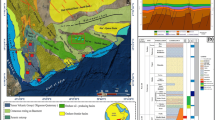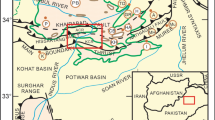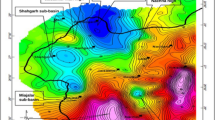Abstract
Organic geochemical and palynofacies analyses were carried out on shale intervals of the Late Paleocene Patala Formation at Nammal Gorge Section, western Salt Range, Pakistan. The total organic carbon content and Rock-Eval pyrolysis results indicated that the formation is dominated by type II and type III kerogens. Rock-Eval \({T}_{\mathrm{max}}\) vs. hydrogen index (HI) and thermal alteration index indicated that the analysed shale intervals present in the formation are thermally mature. \(S_{1}\) and \(S_{2}\) yields showed poor source rock potential for the formation. Three palynofacies assemblages including palynofacies-1, palynofacies-2 and palynofacies-3 were identified, which are prone to dry gas, wet gas and oil generation, respectively. The palynofacies assessment revealed the presence of oil/gas and gas prone type II and type III kerogens in the formation and their deposition on proximal shelf with suboxic to anoxic conditions. The kerogen macerals are dominated by vitrinite and amorphinite with minor inertinite and liptinite. The kerogen macerals are of both marine and terrestrial origin, deposited on a shallow shelf. Overall, the dark black carbonaceous shales present within the formation act as a source rock for hydrocarbons with poor-to-moderate source rock quality, while the grey shales act as a poor source rock for hydrocarbon generation.














Similar content being viewed by others
References
Al-Belushi B 2006 Palynological and integrated geological study of the Gharif Formation, Hasirah Field, West Central Oman; MS Thesis, Department of Earth Sciences, Sultan Qaboos University, Oman.
Assaad F A 2008 Field methods for petroleum geologists: A guide to computerized lithostratigraphic correlation charts case study; Springer Science & Business Media, Northern Africa.
Baker D M, Lillie R J, Yeats R S, Johnson G D, Yousuf M and Zamin A S H 1988 Development of the Himalayan frontal thrust zone: Salt Range, Pakistan; Geology 16 3–7.
Behar F, Beaumont V and Pentea B 2001 Rock-Eval 6 Technology: Performances and development. Oil Gas Sci. Technol. Rev. IFB 56 111–134.
Bostick N H 1971 Thermal alteration of clastic organic particles as an indicator of contact and burial metamorphism in sedimentary rocks; Geosci. Man. 3(1) 83–92.
Ding W, Wan H, Zhang Y and Han G 2013 Characteristics of the Middle Jurassic marine source rocks and prediction of favorable source rock kitchens in the Qiangtang Basin of Tibet; J. Asian Earth Sci. 66 63–72.
Dow W G 1982 Kerogen maturity and type by reflected light microscopy applied to petroleum exploration (eds) Staplin F L, Dow W G, Milner C W O, Connor D I, Pocock S A J, Gijzel P V, Welte D H and Yukler M A, Soc. Econ. Paleontol. Mineral. Short Course 7 133–157.
Emery D and Myers K J 1996 Sequence stratigraphy; Oxford, Blackwell Science, pp. 136–145.
Ercegovac M and Kostić A 2006 Organic facies and palynofacies: Nomenclature, classification and applicability for petroleum source rock evaluation; Int. J. Coal Geol. 68(1) 70–78.
Fatmi A N 1973 Lithostratigraphic units of the Kohat-Potwar Province Indus Basin, Pakistan; Mem. Geol. Surv. Pak. 10 1–180.
Fazeelat T, Jalees M I and Bianchi T S 2010 Source rock potential of Eocene, Paleocene and Jurassic deposits in the subsurface of the Potwar Basin, northern Pakistan; J. Pet. Geol. 33(1) 87–96.
Filho M J G, de Oliveira A D, da Silva F S, de Oliveira Mendonça J, Rondon N F, da Silva T F and Menezes T R 2012 Organic facies: Palynofacies and organic geochemistry approaches; In: Earth’s system processses, INTECH Open Access Publisher.
Gee E R 1989 Overview of the geology and structure of the Salt Range, with observations on related areas of northern Pakistan; In: Tectonics of the western Himalayas (eds) Malinconico L L and Lillie R J, Geol. Soc. Am. Spec. Paper 232 95–112.
Grelaud S, Sassi W, de Lamotte D F, Jaswal T and Roure F 2002 Kinematics of eastern Salt Range and South Potwar Basin (Pakistan): A new scenario; J. Mar. Pet. Geol. 19 1127–1139.
Hakimi M H and Abdullah W H 2014 Source rock characteristics and hydrocarbon generation modelling of upper Cretaceous Mukalla Formation in the Jiza-Qamar Basin, eastern Yemen; Mar. Pet. Geol. 51 100–116.
Hakimi M H, Abdullah W H, Sia S G and Makeen Y M 2013 Organic geochemical and petrographic characteristics of Tertiary coals in the northwest Sarawak, Malaysia: Implications for palaeoenvironmental conditions and hydrocarbon generation potential; Mar. Pet. Geol. 48 31–46.
Hakimi M H, Abdullah W H, Shalaby M R and Alramisy G A 2014 Geochemistry and organic petrology study of Kimmeridgian organic-rich shales in the Marib-Shabowah Basin, Yemen: Origin and implication for depositional environments and oil-generation potential; Mar. Pet. Geol. 50 185–201.
Hanif M, Ali F and Afridi B Z 2013 Depositional environment of the Patala Formation in biostratigraphic and sequence stratigraphic context from Kali Dilli Section, Kala Chitta Range; J. Himal. Earth Sci. 46(1) 55–65.
Hunt J M 1995 Petroleum geochemistry and geology; 2nd edn, Freeman, San Francisco.
Iqbal S, Jan I U and Hanif M 2014 The Mianwali and Tredian formations: An example of the Triassic progradational deltaic system in the low-latitude western Salt Range, Pakistan; Arab; J. Sci. Eng. 39(7) 5489–5507.
Jan I U, Shah A, Stephenson M H, Iqbal S, Hanif M, Wagreich M and Hussain H S 2016 The sedimentology of the Lower Permian Dandot Formation: A component of the Gondwana deglaciation sequence of the Salt Range, Pakistan; Res. Paleontol. Stratigr. 122(1) 75–90.
Jiang D X, Wang Y D, Robbins E I, Wei J and Tian N 2008 Mesozoic non-marine petroleum source rocks determined by palynomorphs in the Tarim Basin, Xinjiang, northwestern China; Geol. Mag. 145(6) 868–885.
Kadri I B 1995 Petroleum geology of Pakistan; Pakistan Petroleum Limited, Karachi, pp. 3–14, 109–114.
Kazmi A H and Jan M Q 1997 Geology and tectonics of Pakistan; Graphic Publishing, Karachi, pp. 121–129, 235–249.
Khan N 2016 Hydrocarbon source rock potential evaluation of the Early Jurassic Datta Formation Salt Range, Pakistan; MS Thesis, National Centre of Excellence in Geology, University of Peshawar, Pakistan.
Lafargue E, Marquis F and Pillot D 1998 Rock-Eval 6 applications in hydrocarbon exploration, production and soil contamination studies; Oil Gas Sci. Technol. 53 421–437.
Lorente M 1990 Digital image analysis: An approach for quantitative characterization of organic facies and palynofacies; Mededelingen Rijks Geologische Dienst. 45 103–109.
Makky A F, El Sayed M I, El-Ata A S A, El-Gaied I M A, Abdel-Fattah M I and Abd-Allah Z M 2014 Source rock evaluation of some upper and lower Cretaceous sequences, West Beni Suef Concession, Western Desert, Egypt; Egypt. J. Pet. 23(1) 135–149.
Maravelis A, Makrodimitras G, Pasadakis N and Zelilidis A 2013 Stratigraphic evolution and source rock potential of a Lower Oligocene to Lower–Middle Miocene continental slope system, Hellenic Fold and Thrust Belt, Ionian Sea, northwest Greece; Geol. Mag. 151(3) 394–413.
Mashhadi Z S, Rabbani A R, Kamali M R, Mirshahani M and Khajehzadeh A 2015 Burial and thermal maturity modeling of the Middle Cretaceous–Early Miocene petroleum system, Iranian sector of the Persian Gulf; Pet. Sci. 12(3) 367–390.
Mirzaloo M and Ghasemi-Nejad E 2012 Combined use of palynology and organic geochemistry in petroleum potential evaluation and paleoenvironmental interpretation of the Kazhdumi Formation (Aptian–Cenomanian) in the southwestern Zagros Basin, Iran; Geopersia 2(1) 27–40.
Mustapha K A and Abdullah W H 2013 Petroleum source rock evaluation of the Sebahat and Ganduman Formations, Dent Peninsula, Eastern Sabah, Malaysia; J. Asian Earth Sci. 76 346–355.
Pacton M, Gorin G E and Vasconcelos C 2011 Amorphous organic matter – Experimental data on formation and the role of microbes. Revi. Palaeobot. Palynol. 166(3) 253–267.
Peters K E 1986 Guidelines for evaluating petroleum source rock using programmed pyrolysis; Am. Assoc. Pet. Geol. Bull. 70(3) 318–329.
Peters K E and Cassa M R 1994 Applied source rock geochemistry; In: The petroleum system: From source to trap (eds) Magoon L B and Dow W G, Am. Assoc. Pet. Geol. Mem. 60 93–120.
Pittet B and Gorin G E 1997 Distribution of sedimentary organic matter in a mixed carbonate-siliciclastic platform environment: Oxfordian of the Swiss Jura Mountains; Sedimentology 44(5) 915–937.
Pross J, Pletsch T, Shillington D J, Ligouis B, Schellenberg F and Kus J 2007 Thermal alteration of terrestrial palynomorphs in mid-Cretaceous organic-rich mudstones intruded by an igneous sill (Newfoundland Margin, ODP Hole 1276A); Int. J. Coal Geol. 70(4) 277–291.
Sameeni S J, Haneef M, Rehman O and Lipps J 2009 Paleogene biostratigraphy of Kohat area, northern Pakistan; Geol. Bull. Punjab Univ. 44 27–42.
Sameeni S J, Imtiaz R, Saleem H, Haneef M and Naz H 2014 Biostratigraphy of the Patala Formation, Makarwal Area, Surghar Range, Northern Pakistan; Sci.-Int. (Lahore) 26 745–753.
Selley R C and Sonnenberg S A 2014 Elements of petroleum geology; 3rd edn, Academic Press, San Diego, pp. 10–35, 342–382.
Shah S M I 1977 Precambrian. In: Stratigraphy of Pakistan (ed.) Shah S M I, Geol. Surv. Pak. Mem. 12 1–5.
Shah S M I 2009 Stratigraphy of Pakistan; Govt. Pak. Ministry of Petrol. Nat. Resour. Geol. Surv. Pak. 22 1–5, 243–244.
Singh H and Mahesh S 2015 Palynofacies characterization for evaluation of hydrocarbon source rock potential of Lower Paleogene (Thanetian-Ypresian) sub-surface sediments of Barmer Basin, western Rajasthan, India; Mar. Pet. Geol. 59 442–450.
Traverse A 2007 Topics in geobiology, paleopalynology; 2nd edn, Springer, Dordrecht, the Netherlands.
Treloar P J, Coward M P, Chambers A F, Izatt C N and Jackson K C 1992 Thrust geometries and rotations in the northwest Himalaya; In: Thrust tectonics (ed.) McClay K R, Chapman and Hall, London, pp. 325–343.
Tschudy R H 1961 Palynomorphs as indicators of facies environments in Upper Cretaceous and Lower Tertiary strata, Colorado and Wyoming; 16th Annual Field Conference, Guidebook, Wyoming Geological Society, pp. 53–59.
Tucker M E 2003 Sedimentary rocks in the field; John Wiley and Sons.
Tyson R V 1995 Sedimentary organic matter: Organic facies and palynofacies; Chapman and Hall, London, pp. 12–25, 134–196.
van Krevelen D W 1993 Coal: Typology–physics–chemistry–constitution; 3rd edn, Elsevier Science, Amsterdam, pp. 979–982.
Wandrey C J, Law B E and Shah H A 2004 Patala-Nammal composite total petroleum system, Kohat-Potwar geologic province, Pakistan, United States (US) Department of the Interior; US Geol. Surv. Bull. 2208-C 2–10.
Yeats R S, Khan S H and Akhtar M 1984 Late quaternary deformation of the Salt Range of Pakistan; Geol. Soc. Am. Bull. 95(8) 958–966.
Zaidi S N A, Brohi I A, Ramzan K, Ahmed N, Mehmood F and Brohi A 2013 Distribution and hydrocarbon potential of Datta sands in Upper Indus Basin, Pakistan; Sindh Univ. Res. J. (Sci. Ser.) 45(2) 325–332.
Zhang M, Ji L, Wu Y and He C 2015 Palynofacies and geochemical analysis of the Triassic Yanchang Formation, Ordos Basin: Implications for hydrocarbon generation potential and the paleoenvironment of continental source rocks; Int. J. Coal Geol. 152 159–176.
Zobaa M K, El Beialy S Y, El-Sheikh H A and El Beshtawy M K 2013 Jurassic-Cretaceous palynomorphs, palynofacies, and petroleum potential of the Sharib-1X and Ghoroud-1X wells, northwestern Desert, Egypt; J. Afr. Earth Sci. 78 51–65.
Acknowledgements
The authors acknowledge the Department of Geology, University of Malakand for providing facilities and finances for fieldwork and laboratory analyses. NCEG is also acknowledged for providing facilities regarding palynological analyses. Mr Imran Ud Din, MS Scholar at NCEG is acknowledged for his help during the palynofacies samples processing.
Author information
Authors and Affiliations
Corresponding author
Additional information
Corresponding editor: Partha Pratim Chakraborty
Rights and permissions
About this article
Cite this article
Khan, N., Anjum, N., Ahmad, M. et al. Hydrocarbon source rock potential evaluation of the Late Paleocene Patala Formation, Salt Range, Pakistan: Organic geochemical and palynofacies approach. J Earth Syst Sci 127, 98 (2018). https://doi.org/10.1007/s12040-018-0998-0
Received:
Revised:
Accepted:
Published:
DOI: https://doi.org/10.1007/s12040-018-0998-0




